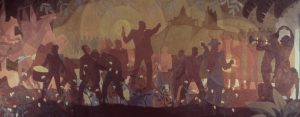
The 1920s and 1930s were a key era for black art and activism. What became known as the Harlem Renaissance is seen as the emergence of a modern black aesthetic and identity in the United States. A new generation calling themselves the New Negro challenged racism and second class citizenship while seeking to create a new space for themselves in the American consciousness.
We’ll look at the Renaissance as an international event, shaped by migration to New York of people of African descent from the southern U.S. and the Caribbean and responding to the experience of World War I and the rise of U.S. imperialism in places like Haiti, Cuba and Puerto Rico. We will focus especially on the institutions that helped support and shape the artistic renaissance, including literary journals and newspapers, white patronage, and political organizations ranging from the NAACP and African Blood Brotherhood to the Communist International.
In addition to learning about African American art and culture, the course will also train students in archival research and print culture studies, as we read literary work by major figures like Langston Hughes, Zora Neale Hurston, Countee Cullen and Claude McKay in the context of its original publication.
This course counts towards the Africana Studies major and minor as well as the English Literary Studies major and minor. It fulfills CCC requirements for AHLG, ARHC, DUSC, and EGHU. It is also a W2 course.